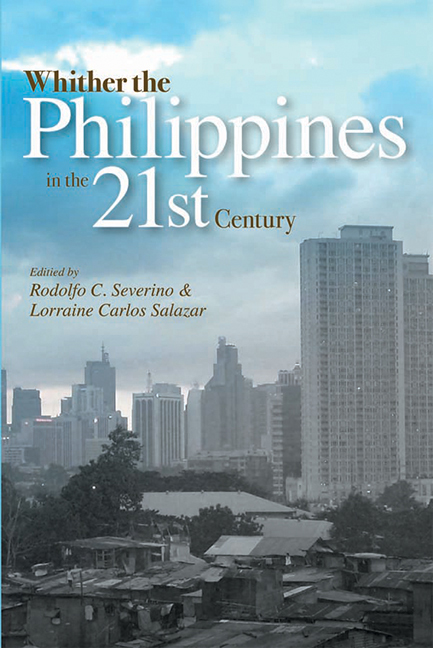Book contents
- Frontmatter
- Contents
- List of Illustrations
- Foreword
- Acknowledgements
- The Contributors
- List of Abbreviations
- Map of Southeast Asia
- 1 The Philippines in Southeast Asia
- 2 From Regime Crisis to System Change
- 3 Proposed Constitutional Reforms for Good Governance and Nation Building
- 4 The Military in Philippine Politics
- 5 Religion and Politics
- 6 The Philippine Press
- 7 Macroeconomic Issues and Challenges
- 8 Investment Climate and Business Opportunities
- 9 Why Does Poverty Persist in the Philippines?
- 10 Diaspora, Remittances, and Poverty
- 11 The Philippine Development Record
- 12 Sancho Panza in Buliok Complex
- 13 The Insurgency That Would Not Go Away
- 14 Whither the Philippines in the 21st Century?
- Index
9 - Why Does Poverty Persist in the Philippines?
Published online by Cambridge University Press: 21 October 2015
- Frontmatter
- Contents
- List of Illustrations
- Foreword
- Acknowledgements
- The Contributors
- List of Abbreviations
- Map of Southeast Asia
- 1 The Philippines in Southeast Asia
- 2 From Regime Crisis to System Change
- 3 Proposed Constitutional Reforms for Good Governance and Nation Building
- 4 The Military in Philippine Politics
- 5 Religion and Politics
- 6 The Philippine Press
- 7 Macroeconomic Issues and Challenges
- 8 Investment Climate and Business Opportunities
- 9 Why Does Poverty Persist in the Philippines?
- 10 Diaspora, Remittances, and Poverty
- 11 The Philippine Development Record
- 12 Sancho Panza in Buliok Complex
- 13 The Insurgency That Would Not Go Away
- 14 Whither the Philippines in the 21st Century?
- Index
Summary
INTRODUCTION
Addressing the widespread poverty problem is the single most important policy challenge facing the Philippines. Not only is poverty high compared with other countries in East Asia, but also its reduction is so slow that the country has become the basket case in the region.
Proposals peddled to address the poverty problem are plenty — and they keep on growing. At one end of the spectrum are proposals contending that the root of the problem is simply the lack of respectable economic growth. Putting the economy on a high-growth path is prescribed as all that is needed to beat the poverty problem. At the other end are proposals asserting that the poverty problem is nothing but a concrete manifestation of gross economic and social inequities. Redistributing wealth and opportunities is viewed as the key to winning the war on poverty. A variant of such proposals holds that economic growth does not at all benefit the poor. Focusing on growth rather than on redistributive reforms is seen to exacerbate inequities, which could lead to the further erosion of peace and social stability. Between these extremes are views that consider economic growth as a necessary condition for poverty reduction and recognize that reform measures have to be put in place to enhance the participation of the poor in growth processes. Most advocates of poverty-reduction ideas, including proponents of the so-called “pro-poor growth”, belong to this mold, although not necessarily sharing common ground on what, conceptually and operationally, constitutes pro-poor growth processes.
How do these proposals stand in relation to evidence and policy research? What are facts and what are fancies? Given the country's fiscal bind, what policy levers can be expected to generate high returns in poverty reduction?
This chapter attempts to answer these questions. It does this by examining the Philippine experience in poverty reduction from an “international” perspective. The next two sections characterize the nature, pattern, and proximate determinants of poverty reduction during the past twenty years.
- Type
- Chapter
- Information
- Whither the Philippines in the 21st Century? , pp. 202 - 221Publisher: ISEAS–Yusof Ishak InstitutePrint publication year: 2007

